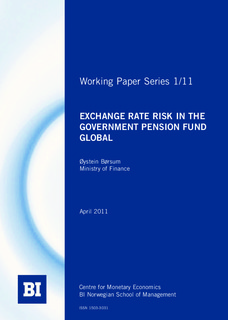Exchange rate risk in the Government Pension Fund Global
Working paper

Åpne
Permanent lenke
http://hdl.handle.net/11250/95297Utgivelsesdato
2011Metadata
Vis full innførselSamlinger
- CME Working Papers [113]
Sammendrag
The Government Pension Fund Global (the Fund) is an important instrument of
national saving. In a national perspective, the Fund's role is to save from the cur-
rent export surplus (oil and gas) to nance future purchases of goods and services
produced abroad (imports). In this perspective, exchange rate risk relates to the
di erence between the currency allocation in the Fund and the currency composi-
tion of future imports. Exchange rate risk amounts to deviations from international
purchasing power parity (PPP) in tradable goods. A literature review suggests that
the evidence for PPP in the long run is considerably stronger today than commonly
thought 10-15 years ago. Also, it seems justi ed to expect large deviations from
PPP to be signi cantly more short-lived than previously thought. Given the Fund's
long investment horizon and regular withdrawals through the scal policy guide-
line, exchange rate risk seems small. This warrants a change in the geographical
allocation of the Fund. Today, more than half of the Fund's capital is invested in
Europe { a certain form of \home bias." There no longer appears to be a basis for
such a strong concentration of the investments. In fact, an argument can be made
to invest more in countries that are farther from home, e.g. in emerging markets.